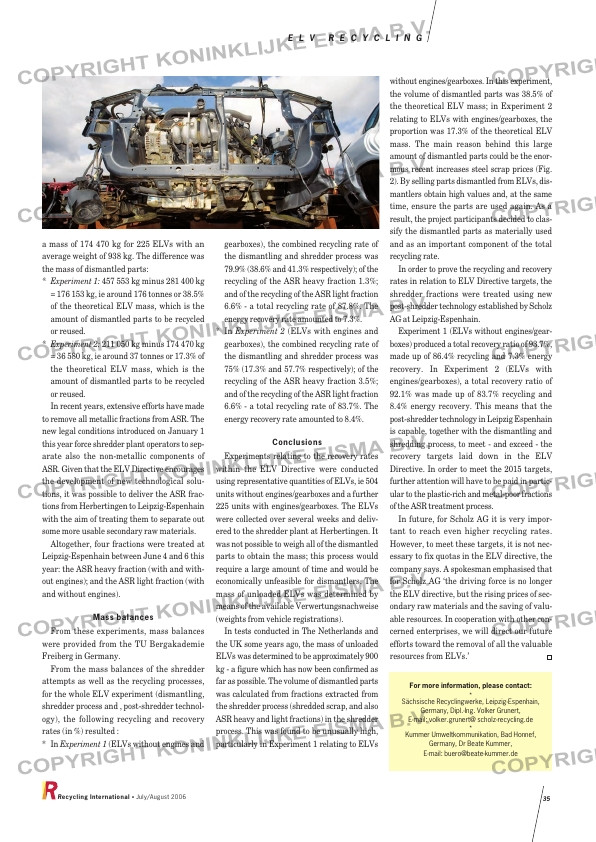Page 35 from: July / August 2006

a mass of 174 470 kg for 225 ELVs with an
average weight of 938 kg. The difference was
the mass of dismantled parts:
* Experiment 1: 457 553 kg minus 281 400 kg
= 176 153 kg, ie around 176 tonnes or 38.5%
of the theoretical ELV mass, which is the
amount of dismantled parts to be recycled
or reused.
* Experiment 2: 211 050 kg minus 174 470 kg
= 36 580 kg, ie around 37 tonnes or 17.3% of
the theoretical ELV mass, which is the
amount of dismantled parts to be recycled
or reused.
In recent years, extensive efforts have made
to remove all metallic fractions from ASR. The
new legal conditions introduced on January 1
this year force shredder plant operators to sep-
arate also the non-metallic components of
ASR. Given that the ELV Directive encourages
the development of new technological solu-
tions, it was possible to deliver the ASR frac-
tions from Herbertingen to Leipzig-Espenhain
with the aim of treating them to separate out
some more usable secondary raw materials.
Altogether, four fractions were treated at
Leipzig-Espenhain between June 4 and 6 this
year: the ASR heavy fraction (with and with-
out engines); and the ASR light fraction (with
and without engines).
Mass balances
From these experiments, mass balances
were provided from the TU Bergakademie
Freiberg in Germany.
From the mass balances of the shredder
attempts as well as the recycling processes,
for the whole ELV experiment (dismantling,
shredder process and , post-shredder technol-
ogy), the following recycling and recovery
rates (in %) resulted :
* In Experiment 1 (ELVs without engines and
gearboxes), the combined recycling rate of
the dismantling and shredder process was
79.9% (38.6% and 41.3% respectively); of the
recycling of the ASR heavy fraction 1.3%;
and of the recycling of the ASR light fraction
6.6% – a total recycling rate of 87.8%. The
energy recovery rate amounted to 7.3%.
* In Experiment 2 (ELVs with engines and
gearboxes), the combined recycling rate of
the dismantling and shredder process was
75% (17.3% and 57.7% respectively); of the
recycling of the ASR heavy fraction 3.5%;
and of the recycling of the ASR light fraction
6.6% – a total recycling rate of 83.7%. The
energy recovery rate amounted to 8.4%.
Conclusions
Experiments relating to the recovery rates
within the ELV Directive were conducted
using representative quantities of ELVs, ie 504
units without engines/gearboxes and a further
225 units with engines/gearboxes. The ELVs
were collected over several weeks and deliv-
ered to the shredder plant at Herbertingen. It
was not possible to weigh all of the dismantled
parts to obtain the mass; this process would
require a large amount of time and would be
economically unfeasible for dismantlers. The
mass of unloaded ELVs was determined by
means of the available Verwertungsnachweise
(weights from vehicle registrations).
In tests conducted in The Netherlands and
the UK some years ago, the mass of unloaded
ELVs was determined to be approximately 900
kg – a figure which has now been confirmed as
far as possible. The volume of dismantled parts
was calculated from fractions extracted from
the shredder process (shredded scrap, and also
ASR heavy and light fractions) in the shredder
process. This was found to be unusually high,
particularly in Experiment 1 relating to ELVs
without engines/gearboxes. In this experiment,
the volume of dismantled parts was 38.5% of
the theoretical ELV mass; in Experiment 2
relating to ELVs with engines/gearboxes, the
proportion was 17.3% of the theoretical ELV
mass. The main reason behind this large
amount of dismantled parts could be the enor-
mous recent increases steel scrap prices (Fig.
2). By selling parts dismantled from ELVs, dis-
mantlers obtain high values and, at the same
time, ensure the parts are used again. As a
result, the project participants decided to clas-
sify the dismantled parts as materially used
and as an important component of the total
recycling rate.
In order to prove the recycling and recovery
rates in relation to ELV Directive targets, the
shredder fractions were treated using new
post-shredder technology established by Scholz
AG at Leipzig-Espenhain.
Experiment 1 (ELVs without engines/gear-
boxes) produced a total recovery ratio of 93.7%,
made up of 86.4% recycling and 7.3% energy
recovery. In Experiment 2 (ELVs with
engines/gearboxes), a total recovery ratio of
92.1% was made up of 83.7% recycling and
8.4% energy recovery. This means that the
post-shredder technology in Leipzig Espenhain
is capable, together with the dismantling and
shredding process, to meet – and exceed – the
recovery targets laid down in the ELV
Directive. In order to meet the 2015 targets,
further attention will have to be paid in partic-
ular to the plastic-rich and metal-poor fractions
of the ASR treatment process.
In future, for Scholz AG it is very impor-
tant to reach even higher recycling rates.
However, to meet these targets, it is not nec-
essary to fix quotas in the ELV directive, the
company says. A spokesman emphasised that
for Scholz AG ‘the driving force is no longer
the ELV directive, but the rising prices of sec-
ondary raw materials and the saving of valu-
able resources. In cooperation with other con-
cerned enterprises, we will direct our future
efforts toward the removal of all the valuable
resources from ELVs.’
Recycling International • July/August 2006 35
E L V R E C Y C L I N G
For more information, please contact:
*
Sächsische Recyclingwerke, Leipzig-Espenhain,
Germany, Dipl.-Ing. Volker Grunert,
E-mail: volker.grunert@ scholz-recycling.de
*
Kummer Umweltkommunikation, Bad Honnef,
Germany, Dr Beate Kummer,
E-mail: [email protected]
RI_053 ELV 07-08-2006 16:07 Pagina 35



